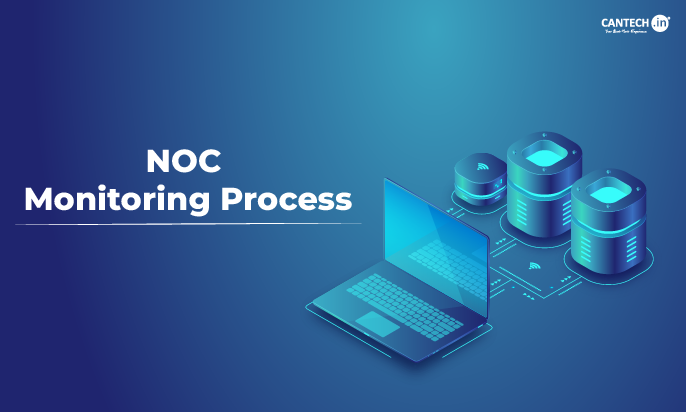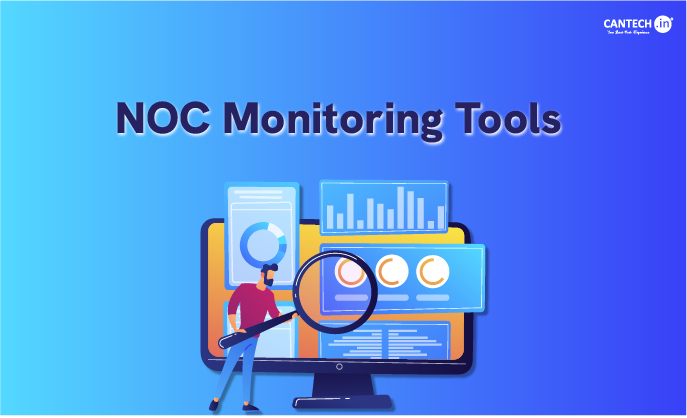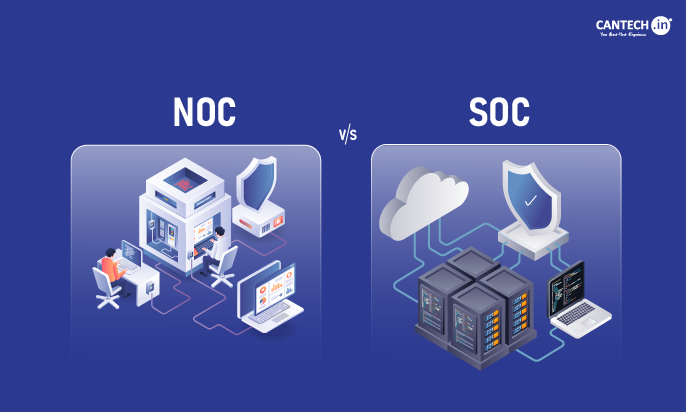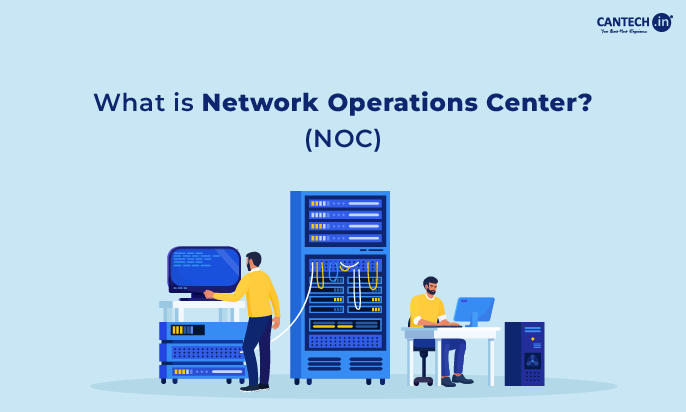Introduction
Did you ever think about how the vast computer networks manage to go on without any notable interruption 24/7? Through NOC monitoring-a vital process that keeps businesses busy guarantees network performance, security, and uptime.
In this blog, we will break down the NOC monitoring process, its workings, the reasons for its importance, and how it supports businesses. Whether you are an IT expert, a business owner, or just curious about network monitoring- this guide will furnish you with all the knowledge you need.
What is NOC Monitoring?
The NOC is a centralized service hub where IT specialists supervise, monitor, and manage real-time network performance, servers, applications, databases, firewalls, and security systems.
NOC monitoring ensures:
- Zero downtime with 24/7 monitoring
- Quick detection of network issues before they escalate
- Enhanced security to prevent cyber threats
- Optimized performance of IT infrastructure
Various industries, such as telecommunications, financial services, e-commerce, healthcare, and cloud computing, count on Managed NOC services for uninterrupted operation.
Key Components of NOC Monitoring
To understand more about what is NOC Monitoring and its process, it is essential to explore its core components.
1. Real-Time Network Monitoring
NOC teams use advanced monitoring tools to track the health and performance of an organization’s IT infrastructure. These include, but are not limited to analyzing traffic and bandwidth usage, measuring server uptime and response time, firewall and security threats, and measuring application performance.
The most popular monitoring tools are Nagios, SolarWinds, Zabbix, Datadog, and PRTG Network Monitor.
2. Incident Detection and Response
In case of a network-related issue, the NOC team will recognize the problem at once, detect its severity and then work to correct it. Low priority issues are mainly logged for minor alerts that do not hamper normal operations. Medium priority issues are those problems that can have an adverse effect on performance but do not lead to downtime. On the other hand, the remaining high-priority issues are critical incidents leading to outages and need immediate resolution. Quick incident response helps reduce downtime and curtails the loss of productivity and revenue.
3. Problem Management & Root Cause Analysis
Aside from stopping issues, NOC teams investigate to discover the cause of a problem and prevent a repeat. Tools such as trend analysis and keeping historical data are applied to find recurring groups of issues.
Example: If the server repeatedly fails because of high CPU usage, the NOC team might recommend using the load balancers or upgrading hardware.
4. Security Monitoring & Threat Prevention
An important portion of the NOC teams would hence be associated with efforts meant to protect the organizations against cybersecurity threats, malware attacks, and data breaches by monitoring firewalls, intrusion detection systems (IDS), security logs, suspicious traffic patterns, and unauthorized access. They can implement automated security patches and updates, fire vulnerability scans or run penetration tests.
5. Performance Optimization & Capacity Planning
Regular system performance analysis helps companies scale their infrastructure based on future demands. NOC teams:
- Predict traffic spikes and adjust resources accordingly
- Optimize bandwidth usage for high-speed connectivity
- Ensure cloud and on-premise servers run at peak efficiency
Capacity planning ensures businesses don’t run into unexpected IT failures due to system overload.
Benefits of NOC Monitoring
Improved Network Uptime
Having a NOC monitoring system monitors the network every hour every day of the week ensures the timely detection and rectification of any issues with the network, well before actual disruption happens. By proactive identification of hardware failures, software crashes, and connectivity issues alike, businesses can swiftly go about their operations, without interruption. Such infrastructure is necessary for industries that rely on transmitting real-time data and online services so that neither customers nor employees experience downtime.
Faster Issue Resolution
The NOC Team monitors the assorted domains in real time and coordinates on alarms, diagnostics, repairs, and various other actions to aid in the fast identification of network failures. Rather than waiting for the escalation of a problem, automated workflows guide technicians through trouble shooting and resolution steps. Thus, businesses can recover quickly, showering in gleaming new lights: even in the possible case of a server failure, several attacks by various cyber criminals, or a connectivity loss at the very least, businesses can recover the activities of the server.
Cost Savings
Unplanned downtime then affects a host of dooms and gloom in terms of setting back progress, unnoticed long-term institutional setbacks or fixes on plant turns, quite notably how plant closures due to partial fires have evaded quiet management. With the continuous monitoring of NOC-compliant systems carried out transparently, IT departments in businesses evaluate the effectiveness of their mission and services by checking for any hidden loopholes by ensuring their patch management is covered while simultaneously building into the process early warning signs of network severity through utilization. This optimization goes a long way in helping organizations plan their maintenance into predictive, rather than reactive, by allowing for the substitution of outdated or failing components as soon as possible in making an efficient spend against IT budgets.
Better Security Compliance
Sectors such as ISO, GDPR, HIPAA, and PCI DSS among many others, operate within near unbelievably tight regulatory confines, making it of dire importance for the continuous activities within the NOC be to ensure constant security oversight by guaranteeing the elimination of unauthorized access, blocking possible cyber threats, and sustaining compliance policies. Automated security updates and diligent patch management build a small offer zone about how to answer almost instantaneously, thus maintaining wholesale penalties from specific regulatory measures.
Scalability and Business Growth
However, with the growth of a business comes the inevitability of its IT infrastructure needing to grow. The insights provided by NOC monitoring on how the network is being utilized engage further business capacity planning for expansions, shoring up cloud resources, and a seamlessly phased-in process for all new technologies. If businesses are trying to add new locations, staff from remote sites, or a high-throughput application, network orchestration ensures management clarity.
How Businesses Can Optimize NOC Monitoring
To get the best out of NOC monitoring, businesses should:
Use AI and Automation
The AI-powered NOC solutions utilize machine-learning algorithms. They look for patterns, predict outages, and resolve issues automatically. Automated network healing acts on minor issues even without human intervention and reduces NOC’s and response time in service restoration.
Implement Multi-Layered Security
With the evolution of cyber risks, businesses must employ a proper layer of security measures. Attackers and malware can be thwarted with firewalls, antivirus software, anti-DDoS mechanism, IDS, and SIEM tools.
Regularly Update and Patch Systems
Many cyberattacks may become successful because of obsolescence of software and associated vulnerabilities. Regular patch management has the positive effect of helping to maintain updated network devices, applications, and security tools to lessen the exposure of an extended attack surface to common threats. Automated patching tools have now come into play, allowing businesses to have bugs fixed and stay protected without any manual intervention nowadays.
Use Cloud-Based Monitoring Solutions
Cloud-based NOC monitoring gives higher flexibility, scalability, and continued access. This means businesses can monitor their infrastructure anywhere in the world, be alerted in real-time, and scale resources as needed. Cloud-based tools also help save on infrastructure costs and increase reliability.
Train IT Teams on Best Practices
The human touch still comes into play in automation. Training sessions with regular intervals for the IT teams will keep these networkers updated with each emerging network threat, advanced troubleshooting techniques, and compliance requirements. Well-trained NOC team members make sure that problems get solved in shorter time frames and operational risks for businesses get thus lowered.
Conclusion
The NOC monitoring process provides an overall backbone for reliable, secured, and high-performing IT infrastructure. The real-time monitoring, advanced security protocols, and AI-driven automation allow us to prevent network failures while improving performance and saving costs altogether. Partners’ investments in NOC will ensure their business resilience, agility, and readiness to tackle challenges posed by this unfolding digital world in the coming years.
Frequently Asked Questions
1. What does a NOC team do?
An NOC team monitors an organization’s IT infrastructure, identifies and resolves issues within a network, provides cybersecurity and optimizes the system performance.
2. Why is NOC monitoring important?
NOC monitoring prevents down and downs, and provides security, compliance, and improvement of overall IT performance.
3. What industries benefit from NOC monitoring?
The ones that cope with telecoms, finance, health, e-commerce, cloud computing, and IT services rely most on NOC monitoring.
4. What are the common tools used for NOC monitoring?
Some popular NOC monitoring tools include Nagios, SolarWinds, Zabbix, Datadog, and PRTG Network Monitor.
5. How does NOC monitoring improve cybersecurity?
Assist the NOC team in monitoring its network actions, identifying security threats, applying patches, and performing other related tasks; compliance with security regulations to donate cyberattacks.
6. Can small businesses benefit from NOC monitoring?
Yes! Small businesses can use outsourced NOC services or cloud-based monitoring solutions to enhance IT reliability and security at an affordable price.




